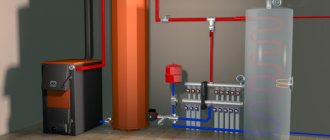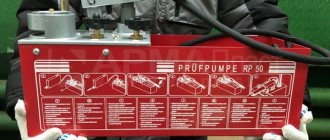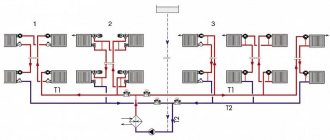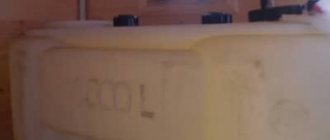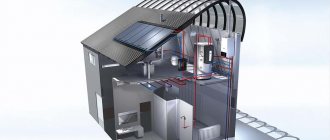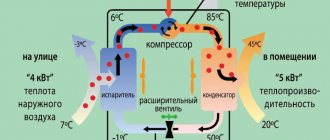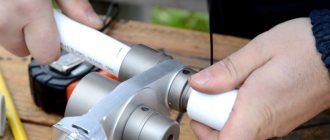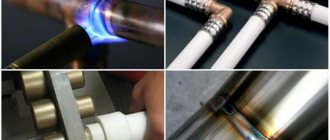How to fill the system correctly
There are two fundamentally different ways to fill water.
Above
This is done using a circulation pump. It is advisable to use electric, especially in systems with a height difference of 10 meters or more.
If there is only a manual device, filling can be done from the top point using a fitting that is connected to the air valve.
The liquid flows by gravity. The drain valve at the bottom must be open. It is blocked as soon as water appears. This helps create a static pressure equal to the height of the circuit divided by 10 atm.
Next, you need to increase the amount of liquid to the working value. A hose is connected to the fitting using a ball valve. On the other hand, an adapter to a pump with a pressure gauge is attached to it. The hose is filled with water with the valve on the pipe closed. It is then transferred to the circuit, creating an air flow from the pump. The procedure is repeated 3-5 times. This must be done carefully so that gas does not enter the pipeline. Otherwise, you will have to clean the system.
From below
For the procedure, you will need a container with a volume of at least 200 liters (more, depending on the system). A pump is placed in it and the necessary pressure is created.
The latter is calculated by the pressure height: the value in meters is divided by 10 and the number in atmospheres is obtained.
The barrel is pre-filled with water. The level must be above the pipe to prevent air from entering. As the pumping progresses, the liquid is added.
When filling with antifreeze, use a small container so as not to contaminate the hose and pump housing. Its amount needs to be replenished more often, periodically stopping the process.
Filling is carried out with open air ducts. The last ones are Mayevsky’s cranes, located on batteries. Objects are placed under them to collect liquid. When it starts to flow, the valves are closed.
Pressure control is carried out using a pressure gauge. If the indicator exceeds the static one (it is taken equal to the pressure length in the circuit divided by 10), water continues to be poured into the system until the required value is obtained.
After completing the process, the pump is turned off. Then the air valves are uncorked. This is necessary to remove gas from the system. In this case, the pressure will drop, so you will need to add fluid.
Attention! Finally, you should inspect the piping for cracks and leaks.
Preparatory work
Performed regardless of the condition of the equipment.
Hydraulic test
Both old and new pipes must be flushed and tested:
- Using water, the piping is cleaned of process debris and scale. With the addition of chemicals, it is possible to remove scale and rust. If the operating rules are followed (the coolant is not drained in the summer), this procedure is carried out with an interval of two years.
- Testing is performed with air at high pressure. For crimping, the working indicator is multiplied by 1.25 (the value varies depending on the material and the volume of water). The pressure during the entire operation can drop by no more than 1%.
Overlapping reinforcement
After completing the inspection, it is necessary to tighten all the valves leading to draining liquid from the radiators, and also close the air valves.
Troubleshooting
During hydraulic tests, the system is inspected for the presence of cracks, cracks, and leaks. After this, you need to check the functionality of the equipment: pump, expansion tank, boiler, etc.
What can lead to traffic jams in the circuit?
The importance of air vents cannot be overstated. Traffic jams in the circuit can lead to different processes:
- circulation disturbance;
- pressure surges;
- reduction in the efficiency of heating equipment;
- corrosion of metal.
Autonomous air vent
Installing an air vent in the heating system prevents the formation of plugs and pockets. When bumping into them, the coolant stops. Sometimes plugs cut off entire sections with radiators from the circuit. At the same time, the pressure in the system increases. When it reaches a critical level, an emergency release of coolant occurs. This, in turn, leads to a drop in pressure. At the same time, there are many cases when air collected in the batteries, the circuit continued to work, only half of the radiator became cold. This significantly reduces the heating efficiency and slightly increases the cost of its operation.
For open systems, one of the most serious threats is rust. At the same time, the question of how to remove air from the heating system arises only at the design stage. Such circuits are assembled at an angle from pipes with a large diameter, so there is a lot of water in the system. Considering the fact that the coolant is in contact with air and draws it into circulation, the oxygen level in the pipes is more than sufficient. Since it takes a long time to remove air from the heating system, oxygen reacts intensively with the metal. The result of the interaction is the formation of corrosion on the inner walls of the pipes. Rust sometimes eats up the tank so much that you have to replace it.
The direct consequences of traffic jams in the circuit entail indirect ones, which are no less dangerous:
defrosting the system.
Occurs if the valve for bleeding air from the heating system and all sensors are in good working order and working correctly. Due to the increase in pressure, an emergency release of the coolant occurs, which leads to a decrease in its quantity in the circuit. After cooling, there will not be enough fluid in the system, and the pressure will drop sharply. If it does not correspond to the minimum required to turn on the boiler, the heater will not turn on. And from this moment in winter, the countdown begins when the pipes defrost. Depends on how insulated the house is. Sometimes this happens in just three hours. In this case, unpleasant news awaits you at home from work;
boiler explosion.
This occurs if there is a malfunction of the valve for bleeding air from the heating system, or the temperature-controlling equipment. An unlikely situation, although possible. The results of this are very disastrous. At best, repair or replacement of the boiler; at worst, injury;
rupture of the circuit and release of the hot water fountain.
A very likely situation is that the joints may not be tightened enough. As the pressure increases, they cannot withstand and crack. At the same time, hot coolant flows from the pipe like a fountain. Not only does the circuit need to be repaired, but the neighbors also need to repair the ceiling, since you flooded it thoroughly. This is the kind of chain that can be caused by simply airing the system.
Filling the heating system
The methods for filling an open and closed heating system differ.
How to pour into a closed
The closed system is equipped with a sealed expansion tank, which can be installed at will.
Attention! It is not recommended to use the upper tier of the system to fill the coolant. In this case, the air exits through the coolant layer, saturating it
When heated, air pockets form throughout the circuit.
The best option is to supply coolant through the bottom valve:
- from the water supply;
- from a container or well using a pump.
Photo 2. Diagram of a closed heating system. A sealed expansion tank and pump are installed in it.
The process itself is carried out at the beginning of the heating season or after repair work.
High-quality antifreeze can be refilled every 5-6 years.
If the liquid supply is not from a water supply, then a pump will be needed. The source is a well or container. Filling process:
- It is better to fill the system together, then it will be easier to control the pressure.
- The coolant is pumped when the heat source is turned off.
- All shut-off valves open, only the drain remains closed.
- The radiators are also overlapped, except for the most distant ones in each branch.
- The coolant supply is connected: the circuit, boiler and tank are filled.
- From the beginning of the process, the air outlet is controlled: it must exit through the safety group valve and the diverter at the top point of the line.
Important! It is recommended to install the safety group on a system with any type of boiler and fuel type. The radiators are opened, starting from the first one from the boiler
The taps are opened, the air is released through the Mayevsky tap, and after filling the radiator is closed again. This process is repeated with all branch radiators
The radiators are opened, starting from the first one from the boiler. The taps are opened, the air is released through the Mayevsky tap, and after filling the radiator is closed again. This process is repeated with all radiators in the branch.
- When the batteries are filled, the accumulated air is released from the circulation pump.
- Next, the heat source is activated and the pump is turned on at the same time. The system is being pumped - without radiators.
- When the pipes are hot enough, the taps on each battery are opened. In this case, it is necessary to once again check the air output from each.
- If everything is done correctly, the pressure stabilizes and is no more than 2 bar.
- The process is repeated for each branch; lastly, the coolant is poured into the heated floor.
If the heating is designed with a manifold, then the branches are filled separately, and the air exits through the manifold valves.
Attention! In the case of a branched structure, pumping and heating of the system is carried out only after filling all parts. The process takes a long time and requires care
If the main points are missed, air may remain in the system, which will subsequently create problems with the heating.
The process takes a lot of time and requires care. If the main points are missed, air may remain in the system, which will subsequently create problems with the heating.
How to upload openly
This is an open container with a lid, which is also a convenient entrance for water to enter the system. Fill with a regular bucket or attach a pump. The difference between filling is the pressure in the circuit: it is equal to normal atmospheric pressure. The coolant is in contact with the environment - an expansion tank is installed at the highest point of the circuit.
Photo 3. Diagram of an open heating system in a two-story building. The circuit is filled with coolant through a special tank.
Filling process:
- If a pump is used, you will need a large container to supply certain volumes.
- Water is poured in gradually, with breaks - this way the air will have the opportunity to escape. If the pump is turned on, the pressure in the circuit should not exceed two atmospheres. The water is stopped when the expansion tank itself begins to fill.
- Next, air is released from all radiators and system components. To do this, open the valves or Mayevsky taps until liquid appears.
- Water is then added to the system. The air is mostly removed independently through the expansion tank; after starting the heat source, this process intensifies. In an open system, the problem of air jams is not as acute as in a closed one.
Evaporation occurs from an open tank, so water will have to be added from time to time.
The circuit is filled from below if there is a corresponding connector.
Solid fuel dual-circuit units
There are several types of such double-circuit boilers. They can be combined into two groups:
- Standard.
- Long burning units.
In the first, the fuel burns very quickly, and therefore you have to add firewood every 2 hours. The latter are pleasing with longer burning: one load of fuel can burn from 12 hours to 5 days . There are also devices with ultra-long burning: one load burns for 30 days. Many experts recommend including them in your home heating project and making all calculations taking such settings into account.
Long-burning boilers are:
- Mine.
- Classic with a large firebox.
- Devices with a cylindrical shape and the principle of fuel combustion “from top to bottom”.
- Pellet.
- Pyrolysis.
Modifications of all these types are only floor-mounted.
Rules and stages for draining water from the heating system
How to properly drain water from the heating system in a house or apartment? It is necessary to take into account the design features of the heating system and follow the procedure.
Draining the heating system in a private house
The heating system of a private house is usually autonomous and draining does not require any permits or agreements with neighbors. It is recommended to drain the heating system in the following order:
- Disconnect the heating boiler from the network.
- The water in the pipes and radiators must cool completely.
- Turn off the cold water tap.
- Open the air valve.
- Open the valves on the radiator and boiler.
- Connect the hose to the drain valve, which is located on the return pipe near the boiler. The other end of the hose must be lowered into the toilet or a large container if the hose is short.
- Open the drain valve.
- Pump out the water until the pressure gauge shows zero.
- Open the Mayevsky tap and let air into the heating system. The air will push out any remaining water.
- Move the hose to the supply valve, open it and drain the liquid from the upper pipe.
A compressor is needed to drain water from the underfloor heating system. It is connected to the inlet pipe, turned on, and the air supply promotes the movement of liquid in the thermal circuit. A drain valve is installed on the return pipe, which opens to remove water. The compressor increases pressure gradually and stops draining when air is released at the outlet. Heated floor circuits have a small capacity and hold no more than 10 liters of water.
After draining the coolant is completed, the necessary actions to repair or reconstruct the system begin. Or they calmly leave the house for the winter, eliminating the risk of rupture of heating pipes.
Draining the heating system in an apartment building
If the radiators in the home have been replaced with new ones, they are equipped with the necessary fittings. In this case, draining the water is not difficult. This is also possible if there are shut-off valves on the path from the riser to the heating radiator. The procedure in this case is as follows:
- Shut off the fluid supply to the battery by turning the control valves.
- Open the outlet valve at the bottom of the battery. Instead of a tap, there may be a plug, then unscrew it with an adjustable wrench.
- Place a bucket to drain the water or connect a hose.
in an apartment building you need to open the outlet valve at the bottom of the battery
Difficulties arise if the battery is old, the shut-off valves are missing or painted over. Then the water will have to be drained from the entire system. It is impossible to do this on your own; you will have to submit an application to the management company. A specialist will turn off the tap in the basement and remove water from a certain riser.
If there is a bypass (vertical jumper between the upper and lower pipes of the radiator) in a single-pipe heating system, the course of action is different:
- Open the bypass valve.
- Close the shut-off valve - turn off the coolant supply.
- Open the outlet valve or plug to drain the water.
Important! If an apartment building is supplied with heat from a closed autonomous heating system, then draining the water yourself is prohibited.
This clause is specified in the agreement with the management company. The system must maintain constant pressure, and self-draining can release this pressure, which will lead to heating problems throughout the house. Therefore, you need to call a specialist to drain the water.
Draining the heating system in an apartment or house is a mandatory procedure before replacing parts of the heating system and carrying out preventive maintenance. During the absence of the owners of a private house in winter, the water must be drained to avoid freezing and damage to the system. To simplify this procedure in the future, the old heating system must be replaced, providing it with all elements of shut-off valves.
Replacing water with antifreeze
If the system has already used water, and you want to switch to antifreeze, then two circumstances should be taken into account.
Secondly
. It is never possible to completely remove water from the heating system. Some of the water remains. If you simply pour prepared diluted antifreeze, its concentration will be insufficient for reliable protection against freezing. Thus, a concentrate must be used. I usually mix concentrate with diluted antifreeze in a 1:1 ratio. After filling the system, you need to start the circulation pump (for a system with forced circulation) or turn on the boiler (for a system with natural circulation) so that the coolant is thoroughly mixed. Then you need to pour out some coolant and measure its density. There is a device for measuring density that is sold in most car dealerships. This device is used to prepare a car for winter (checking the properties of antifreeze in the engine cooling system), but it is also perfect for our purposes. If the device shows a freezing temperature lower than necessary, for example -50 degrees, it’s okay, but if the temperature is higher than we need, then we will have to drain part of the coolant and replace it with concentrate. The drained coolant must be disposed of carefully; it is poisonous and should not be poured into septic tanks or ditches.
I would also like to draw your attention to the fact that different antifreezes may be incompatible with each other. There is an opinion that red composition should not be mixed with a composition of another color.
This is true, but in fact there are other undesirable combinations. Supplements from different brands may react with each other or simply reduce each other's effectiveness. Unfortunately, manufacturers do not indicate what other antifreezes their product can be mixed with. My advice is to pick one brand and stick with it. If you still need to mix, then mix liquids of the same color and before pouring, pour out a little coolant from the heating system, mix it in a jar with a new composition and see if a sediment forms, if the liquid becomes cloudy, or loses its homogeneity.
Filling a closed heating system
A closed heating system is most often used. Its difference from an open one lies in the structure of the expansion tank. In a closed heating complex, the expander is sealed, and the system is filled in a different way.
To begin, prepare all the necessary materials and tools. Including: a volumetric tank, hoses for pumping water from the tank into the system, clamps for firmly fixing the hoses, pliers for installing clamps, a vibrating household pump to forcefully fill the system with water.
Scheme of removing air from the heating system.
Before pumping, you need to hermetically seal the pump with the prepared hoses using clamps. Fill the prepared tank with water and place it near the system filling tap. The pump should also be located nearby. The hose that takes in water should be lowered into the tank, and the hose that supplies the pumped water should be secured with a clamp to the filling valve. Taps and dampers for venting the heating complex must be open. Turn on the pump and start pumping water into the pipes. The pressure on the pressure gauge should gradually increase. When the entire circuit is filled, the pressure gauge readings should reach two atmospheres. Afterwards the pump should be turned off. Disconnect the hoses and turn off the fill valve.
If it is not possible to use a pump to fill the heating complex, then you can use a water supply. The scheme is quite similar to the one described above. It is enough to attach one end of the water intake hose to the water tap, and the other end to the filler in the system and gradually open first the filler and then the water supply. In this case, the pressure will have to be monitored additionally using a separate pressure gauge.
The final operation of filling the system with water will be to remove excess air from its circuit. Modern installations provide special devices for this purpose. You can ventilate the system using this device on the bypass.
Filling the heating system will be most convenient when two people work, since throughout the entire filling process it is necessary to simultaneously monitor the pressure level in the system and the operation of the pump, being near the injection valve, and monitor the tightness and the process of de-aeration of the heating radiators.
Some tips for connecting gas units to the electrical network
Many modern gas units require connection to an electrical outlet (a cable with a plug for connecting to a socket or a three-core insulated wire). In any option, the rule applies: connect the gas unit only through an individual circuit breaker directly to the panel. In addition, grounding must be done. It is unacceptable to use gas or water pipes for grounding. In the event of a power outage, backup sources are provided.
Filling the system correctly
The easiest way is to pump water or antifreeze into pipelines connected to an open expansion tank. To do this, you need to open all the valves (except for the drain) and, by connecting the hose to the make-up fitting, fill the lines and radiators with coolant
In this matter, it is important to take your time and allow the air to leave the system on its own through the expansion tank
Now about how to bleed air from the radiators and pipelines of a closed heating system in a private house. The proposed technique, constantly practiced by our expert, plumber Vitaly Dashko, is performed in the following order:
- Open all shut-off valves of the main circuits (except for the drain).
- Close all radiator valves, excluding the very last batteries at the ends of the loops, so that circulation occurs through them.
- Get an assistant to do the work. Its task is to be in the boiler room and maintain the pressure in the network at a level of 1 bar using a pressure test pump or through a feed branch from the water supply.
- After opening the water supply, fill the main lines, expansion tank and boiler tank. Air must be released through the safety group valve and air vent at the highest point (if equipped).
- Go to the first radiator from the boiler and open both taps at the same time (slowly). Bleed the air through the Mayevsky valve and close the valves again. The assistant at this time does not allow the pressure to drop below 1 bar.
- Repeat the operation on all batteries, then turn on the circulation pump and start the heat generator. When the lines begin to warm up, open all the radiator valves one by one and remove any remaining air from them again.
Important point. Before squeezing air plugs out of radiators, be sure to bleed the air from the circulation pump and turn it on for 5-10 minutes to bleed the pipelines.
After the heating devices have completely warmed up, the pressure in the system should be in the range of 1.3-1.6 Bar. At this point the procedure is considered complete. If the system contains heated floors, then they should be filled last, using the same algorithm (on cold floors!). That is, having pumped up the pressure in the main line, you need to alternately open and close the floor circuits, bleeding air through the manifold valves, and then warm up and adjust the coolant flow.
Note regarding the installation of automatic air release valves. Such a device should always be in the boiler safety group, and the second, third, and so on - only when the lines pass above the radiators. With lower wiring in a one-story house, air accumulates in the radiators, since they are located above the pipelines, and it is not necessary to install valves on them.
Closed systems
These are systems in which the liquid does not come into contact with air outside the system. They have a pump for forced water circulation and an expansion tank with a membrane. We have already written in more detail about the heating system with pump circulation here. The tank is a sealed container, which is internally divided into two parts by a rubber membrane. In its lower part there is a coolant, and in the upper part there is air under a pressure of one and a half atmospheres. It presses on the membrane, as a result of which a constant pressure of 1.5 atm is established in the system.
We'll tell you how to fill a closed heating system without errors. It is better for two people to do the job. One will fill the water, and the second will monitor the drainage of air from the pipes. But if this is not possible, you can simply turn on the water under low pressure. The pipes in this system have a slight upward slope from the boiler to the top point. At this point, a valve is installed through which air is released.
Before filling a closed heating system with water, the valve should be opened and a basin should be placed under it.
Next, the pipes should have a slight slope down to the lowest point. A tap is installed at this location to remove water from the system. There is also a pipe for pumping water into it (usually located just below the boiler). It is equipped with a check valve that allows water to flow in, but prevents it from flowing out. If a water pipe with a tap is connected to the pipe, you should simply open it. If there is no such line, another way to fill the heating system is suitable: using a flexible hose. It must be connected to the water supply system (for example, to a regular faucet in the kitchen) and to the pipe. The pressure in the water supply system should be slightly higher than the pressure of the heating system.
When the pipes and heating radiators are filled with coolant, and water begins to flow from the valve at the top of the system, it should be closed. Then you need to bleed the air from the batteries (using Mayevsky taps). The water is shut off when, after complete deflation of air, its pressure on the pressure gauge built into the boiler reaches one and a half atmospheres (or more if the boiler passport provides for higher pressure in the system).
In double-circuit boilers there is a module for feeding water to the heating system. It contains a tap for pumping water. Therefore, there will be no problems with how to fill the heating system of a double-circuit boiler, because it is easy to do. Just open the tap (at the bottom of the boiler). Through it, the heating system of the house will be filled with water. Although modern boilers are equipped with automatic air venting systems, they do not remove all air from the system. Therefore, installing the valve at its highest point is mandatory.
When starting a gas boiler, another important procedure is performed. Remove the front cover from the boiler and find a cylindrical circulation pump, which has a removable cover in the middle. Turn on the boiler and set it to operating temperature. The pump begins to gurgle due to the presence of air. It needs to be eliminated. To do this, slightly (not completely) unscrew the lid using a screwdriver until water starts dripping from inside. As soon as this happens, screw it back. Wait 2-3 minutes and repeat the procedure a couple more times. When the operation of the device becomes quiet, the electric ignition will turn on. The boiler will start supplying heat in operating mode. Once again they look at the pressure in the system, and if necessary, briefly open the feed tap.
This completes the filling of the closed heating system with water, and all that remains is to carry out additional debugging. It lies in the fact that with the help of control valves on the radiator pipes you can slightly tighten the heat supply to the batteries, which are located near the boiler, and increase its supply to distant radiators. Now there will be no problem with how to properly fill a closed heating system with water, and you can do this work yourself quickly and efficiently.
Stage four: connecting the unit to the gas pipeline
Connecting to a gas pipeline is an extremely important matter. The slightest mistake can be very costly. If installation work is not performed properly, serious emergency situations may arise that can lead to gas poisoning or explosion. There should be no small details when connecting the boiler to the gas pipeline.
The first step is to connect the pipe from the boiler to the gas pipe branch. There must be a shut-off valve on the gas pipe. A special filter for heating is also installed on it.
Important. Filters for the gas pipeline must be reliable and of high quality; you should not skimp on them, since their wear can lead to the gas unit becoming unusable.
When connecting the gas pipeline to the boiler, you need to carefully ensure that all joints are airtight. Here, for sealing, you cannot use FUM tape or sealing thread, which do not provide high-quality insulation. The use of tow and paint is recommended.
Rubber hoses for connecting gas boilers to the gas pipeline are prohibited. Rubber may lose its performance properties (crack), this will inevitably lead to a dangerous gas leak. The hoses are attached to the unit nozzle using union nuts and paronite sealing gaskets. Seals are mandatory here, because they are the ones who will ensure sufficient sealing of the connection.
As for connecting the Baksi boiler to the heating system, you cannot do without the help of specialists. In this case, you can only complete the initial stages of its installation yourself. The boiler will work for a long time and efficiently when its connection is done professionally.
Saline solution
For open-type heating systems with natural coolant circulation, one of the possible coolant options is a concentrated solution of table salt, calcium chloride or other mineral salts. It is used to prevent heating circuit pipes from freezing in winter. Moreover, the stronger the salt concentration, the lower the freezing temperature of the solution.
Technical characteristics of the brine:
- rather low heat capacity - a solution with a salt concentration of 30% gives off 2700 J/kg deg;
- low viscosity;
- very high corrosion activity - steel pipes “burn out” very quickly from constant contact with salt;
- no toxins;
- coefficient of thermal expansion – 0.03%/deg;
- low price of salt.
How to determine the amount of fluid for the system
Scheme of a two-pipe water heating system with natural circulation: 1 – heater;
2 – main riser; 3 – expansion tank; 4 – hot water line; 5 – hot water risers to radiators; 6 – heating radiators; 7 – chilled water drain pipes; 8 – chilled water line (return); 9 – oven. To avoid excessive overflow of water into the heating system or lack of water, which can lead to the destruction of structural elements of the system, boiling of water, and the formation of scale in pipes and radiators, you need to accurately calculate the required volume of water. For this, there is a simple formula that sums up the capacity of all radiators, the heating boiler, the volume of the expansion tank and other additional elements for passing water, including pipes. The formula for calculating the volume of water in pipes is as follows: π (3.14) × r pipes × total length of pipes. About 20% is added to the total value as a margin.
You can also determine the required volume of water to fill the system during flushing by installing a water consumption meter at the entrance to the system. The readings as the system fills must be remembered and used when filling.
Once everything is ready to fill the system, you should prepare or double-check the list of necessary materials and tools.
To do this you will need the following materials:
- gaskets (in case you need to seal pipe connections after checking the tightness of the system);
- sealing tapes for pipes (used to eliminate small leaks from the outside);
- hoses (necessary for supplying water to the vibration household pump and draining water into the heating system);
- plastic container (tank - for collecting coolant before pumping it into the heating system);
- clamps (needed to seal the connections between the hoses and the vibration pump).
Tools:
- pliers (necessary for fixing clamps on hoses to attach them to the pump);
- household vibration pump (used to force water from a container into the heating system);
- pressure gauge (with its help you can easily measure the current pressure in the system).
How to start a gas double-circuit heating boiler for the first time?
The first start-up of heating equipment is an important stage on which the performance of the unit depends.
To connect a double-circuit heating device, it is worth inviting a specialist from the manufacturer. Required for warranty service.
In order for the heating of the living space to be uninterrupted and efficient, you need to act step by step when starting the boiler for the first time:
- filling the dual-circuit system with liquid. To start the heating equipment, you need to fill the communications with water. The devices are often equipped with taps, the opening of which starts the process of drawing water into the system.
First launch
The main thing is to fill the communications gradually, without using a lot of pressure. This will preserve the integrity of the closed system and not damage the heating pipes.
When filling equipment, you need to carefully monitor the pressure. During normal operation, the pressure is 1.5-2 atm. When the mark has reached the indicator, you need to turn off the valve supplying the resource to the system;
Advantages and disadvantages
The use of distilled water as a coolant has both positive and negative sides.
The first include:
- accessibility and low cost;
- non-toxic, so safe for others in case of leakage;
- does not require special storage conditions and compliance with safety rules when filling;
- protects heating pipes from corrosion, scale and various deposits;
- has a greater heat capacity compared to other heat carriers (when cooled by 70 degrees, a heat transfer of 20 Kcal occurs).
The disadvantage is the fact that the distillate freezes at temperatures from -10 to -12 ᵒC Celsius. So, when the heating system is turned off in winter, the pipes will inevitably freeze and fail.
If you do not plan to live in a country house in winter, then it is more rational to choose antifreeze as a coolant that does not freeze.
Main types of coolants
Heating system.
The operating principle of the heating system is that the coolant moves from the heat source to the end point through pipes, heating them. The type and design of the heating equipment determines the type of coolant used, which can be liquids and gases.
The most popular liquid coolants are:
- Water is the most accessible and cheapest resource. According to statistics, about 70% of heating systems use water, which has a high density and heat capacity. In addition, this type of coolant has gained such popularity due to its properties, such as low viscosity, high heat transfer coefficient, and easy temperature control. The main disadvantage is the ability to freeze at zero temperatures. If water freezes in the heating system, this will lead to rupture of pipes and failure of all equipment.
- Antifreeze - this type of coolant is not as widespread as water, and its use is 5%. It is used for heating administrative buildings and residential buildings where the heating system does not allow the use of water due to the increased risk of corrosion. The main advantage of antifreeze is freezing in frosts of 60 - 70 degrees.
The following gases are used as coolant:
- Water vapor is mainly used in industrial buildings, since its use is prohibited in residential and public buildings. Water vapor maintains the temperature of heating devices at 100 degrees; according to sanitary standards, this figure should not exceed 80 degrees.
- Flue gases are toxic, so recently they have been used only for heating water and in order to save electricity to produce a heat source.
- Air is characterized by low heat capacity, so moving it through the heating system requires large energy costs. It is most cost-effective to use air as a coolant, provided that it simultaneously performs two functions: heating and ventilation.
Currently, organic liquids are being introduced as a coolant, which have excellent freezing properties and low viscosity. However, they have not yet become widespread due to their high cost and scarcity.
How to properly fill the system with your own hands
The first thing you need to do before filling the heating system is to calculate the required volume of coolant fluid. This is done simply: add the volumes indicated in the technical documents:
- Pipes and radiators.
- Boiler.
- Expansion tank.
Choice of filling pump: electric or manual
If you are pouring antifreeze or distillate, you will need a pump that will pump the liquid coolant from the reservoir (bucket, boil-off) into the circuit. The pump can be used either electric or manual. A manual one is well suited when there is no electricity and you need to fill the gas heating system.
Photo 4. Hand pump from the manufacturer Instan for pumping coolant into heating systems.
Using a submersible pressure testing hand pump is convenient not only to pour coolant into the system, but also to pressure test it: check for leaks and strength. The only disadvantage of this pump is the long and labor-intensive pumping process.
Washing, crimping and correcting defects
Before pumping, if we are dealing with a fluid change, we need to remove the waste coolant. To do this, open the drain valve. If the coolant does not come out well, we use a circulation pump.
When changing the coolant, the heating circuit must be flushed. The exception to the rule is glycerin antifreeze. When using it, no rinsing is required.
During the pressure testing process, the system is tested for strength and tightness by pumping water under pressure 2-3 times higher than normal. Monitor the pressure gauge readings: if the pressure is maintained, then everything is in order with sealing. And if it falls, you need to look for where the leaks are and correct the shortcomings.
Important! Before the pressure testing procedure, cover the floors with waterproof polyethylene!

